 Sumo (相撲) is a competition contact sport where two wrestlers or rikishi face off in a circular area. The sport is of Japanese origin and is surrounded by ceremony and ritual. The Japanese consider Sumo a gendai budō: a modern Japanese martial art, even though the sport has a history spanning many centuries.
Sumo (相撲) is a competition contact sport where two wrestlers or rikishi face off in a circular area. The sport is of Japanese origin and is surrounded by ceremony and ritual. The Japanese consider Sumo a gendai budō: a modern Japanese martial art, even though the sport has a history spanning many centuries.The Sumo tradition is very ancient, and even today the sport includes many ritual elements, such as the use of salt for purification, from the days Sumo was used in the Shinto religion.
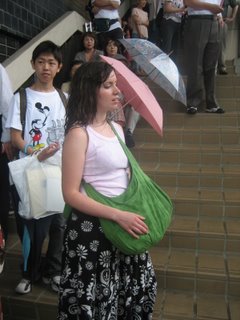
There are six Grand Sumo tournaments (or honbasho) each year: three at The Sumo Hall (or Kokugikan 国技館) in Ryogoku, Tokyo (January, May, and September), and one each in Osaka (March), Nagoya (July) and Fukuoka (November). Each tournament begins on a Sunday and runs for 15 days, ending also on a Sunday. Each sekitori ranked wrestler has one match per day, while the lower ranked rikishi compete in seven bouts, approximately one every two days.

The winner of a Sumo bout is mainly determined by two rules:
The first wrestler to touch the ground with any part of his body other than the soles of his feet loses.
The first wrestler to touch the ground outside the circle loses.
On rare occasions the referee or judges may award the win to the wrestler who touched the ground first; this happens if both wrestlers touch the ground at more or less the same time and it is decided that the wrestler who touched the ground second had no chance of winning as, due to the superior sumo of his opponent, he was already in an irrecoverable position. The losing wrestler is referred to as being shini-tai (“dead body”) in this case.
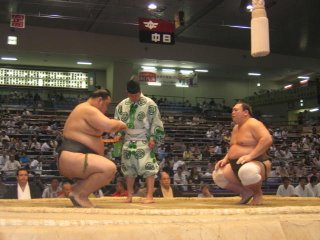

Kristi, Ros, Grace, and I arrived in Nagoya on a rainy day. Made it to the hall around 2'ish and snuck up close (front row exactly) to watch the early sumo matches. We just had to move whenever the real owners of those seats arrived!



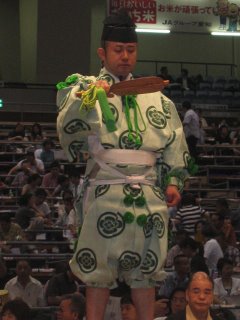 Different ranking officials.
Different ranking officials.



As with many sports, there are a wide variety of souvenirs and memorabilia that fans may acquire. Fans purchasing box seats or front row seats usually purchase the tickets through so-called tea houses, which provide sumo related items in a package that includes the purchase of the ticket. This sort of memorabilia can also be purchased separately. Plates, and cups with sumo related themes are a common item. One of the more unusual items that can be purchased is the tegata (lit. hand shape) of the wrestlers of whom one is a fan. Tegata consist of a hand print of the wrestler accompanied by his fighting name written in calligraphic style by the wrestler himself. The ink for the hand print itself can be either red or black. Original tegata can be quite expensive, but printed copies of the most popular wrestlers can be obtained very inexpensively. Only wrestlers in the top two Juryo and Makuuchi divisions are permitted to make them. Another popular collectible is a copy of the banzuke for a tournament. A banzuke is a document that has been meticulously handwritten in calligraphic script and lists every wrestler who participates in a tournament in order of rank.

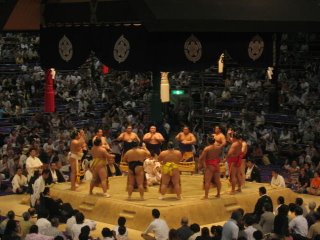
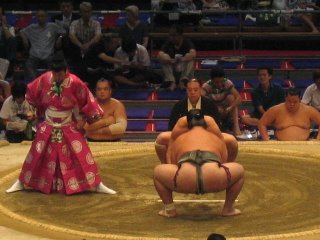 Sumo matches take place in a ring called a dohyō (土俵). The dohyō is made of a mixture of clay and sand spread over the top. It is between 34 and 60 cm high. It is removed after each sumo tournament, and in the case of Nagoya, pieces are taken home by the fans as souvenirs. A new dohyō is built prior to each tournament by the yobidashi, who are responsible for this activity. The yobidashi also build the dohyō for training stables and sumo touring events.
Sumo matches take place in a ring called a dohyō (土俵). The dohyō is made of a mixture of clay and sand spread over the top. It is between 34 and 60 cm high. It is removed after each sumo tournament, and in the case of Nagoya, pieces are taken home by the fans as souvenirs. A new dohyō is built prior to each tournament by the yobidashi, who are responsible for this activity. The yobidashi also build the dohyō for training stables and sumo touring events.The circle in which the match takes place is 4.55 meters in diameter and bounded by rice-straw bales called tawara (俵), which are buried in the clay. The rice bales are 1/3 standard size and are partially buried in the clay of the dohyō. Four of the tawara are placed slightly outside the line of the circle. In olden times this was to allow rain to run off the surface, when sumo tournaments were held outdoors in the open. Today a wrestler under pressure at the edge of the ring will often try to move himself round to one of these points to gain leverage in order to push back more effectively against the opponent who is trying to force him out.
At the center are two white lines, the shikiri-sen (仕切り線), behind which the rikishi must position themselves at the start of the bout. Around the ring is finely brushed sand called the ja-no-me (蛇の目 snake's eye), which can be used to determine if a wrestler has just touched his foot, or another part of his body, outside the ring. The yobidashi ensure it is clean of any previous marks immediately prior to each bout.





Matches often last only a few seconds, as usually one wrestler is quickly ousted from the circle or thrown to the clay. However they can occasionally last for several minutes. Each match is preceded by an elaborate ceremonial ritual. The wrestlers themselves are renowned for their great girth, as body mass is often a winning factor in sumo, though with skill, smaller wrestlers can topple far larger opponents.

 The hall sort of empty at first.
The hall sort of empty at first. Full near the ending matches.
Full near the ending matches. When the final match ended, people upset with the results were throwing their purple cushions.
When the final match ended, people upset with the results were throwing their purple cushions.http://en.wikipedia.org/wiki/Sumo

0 件のコメント:
コメントを投稿